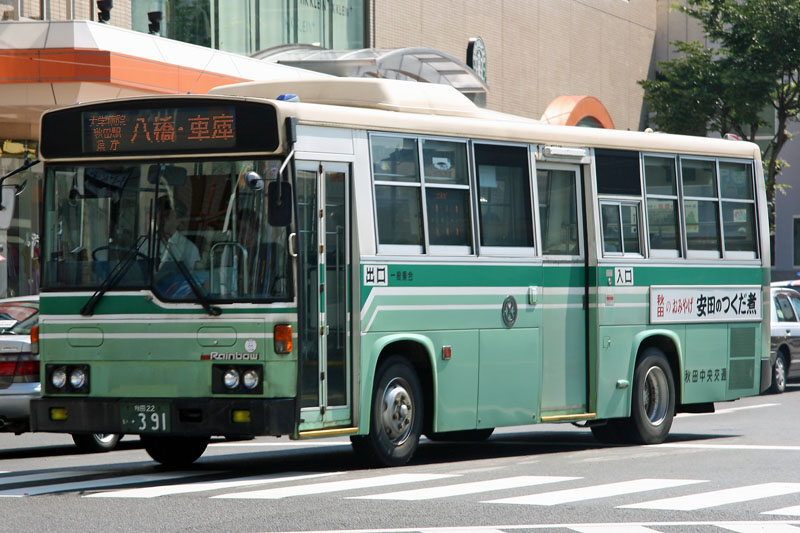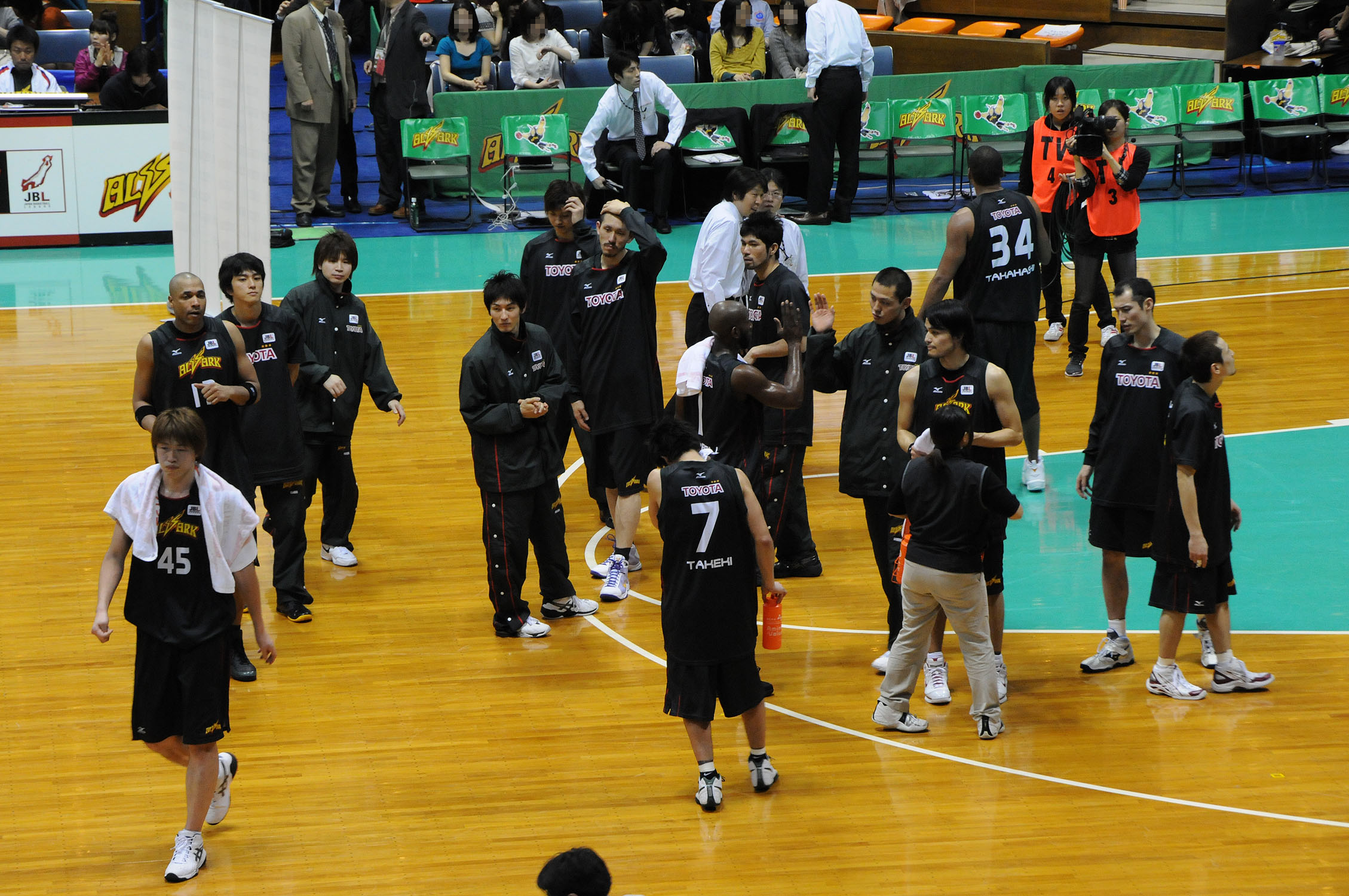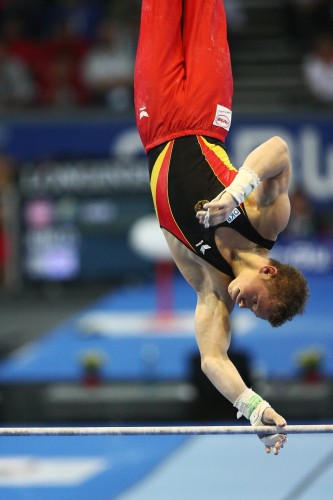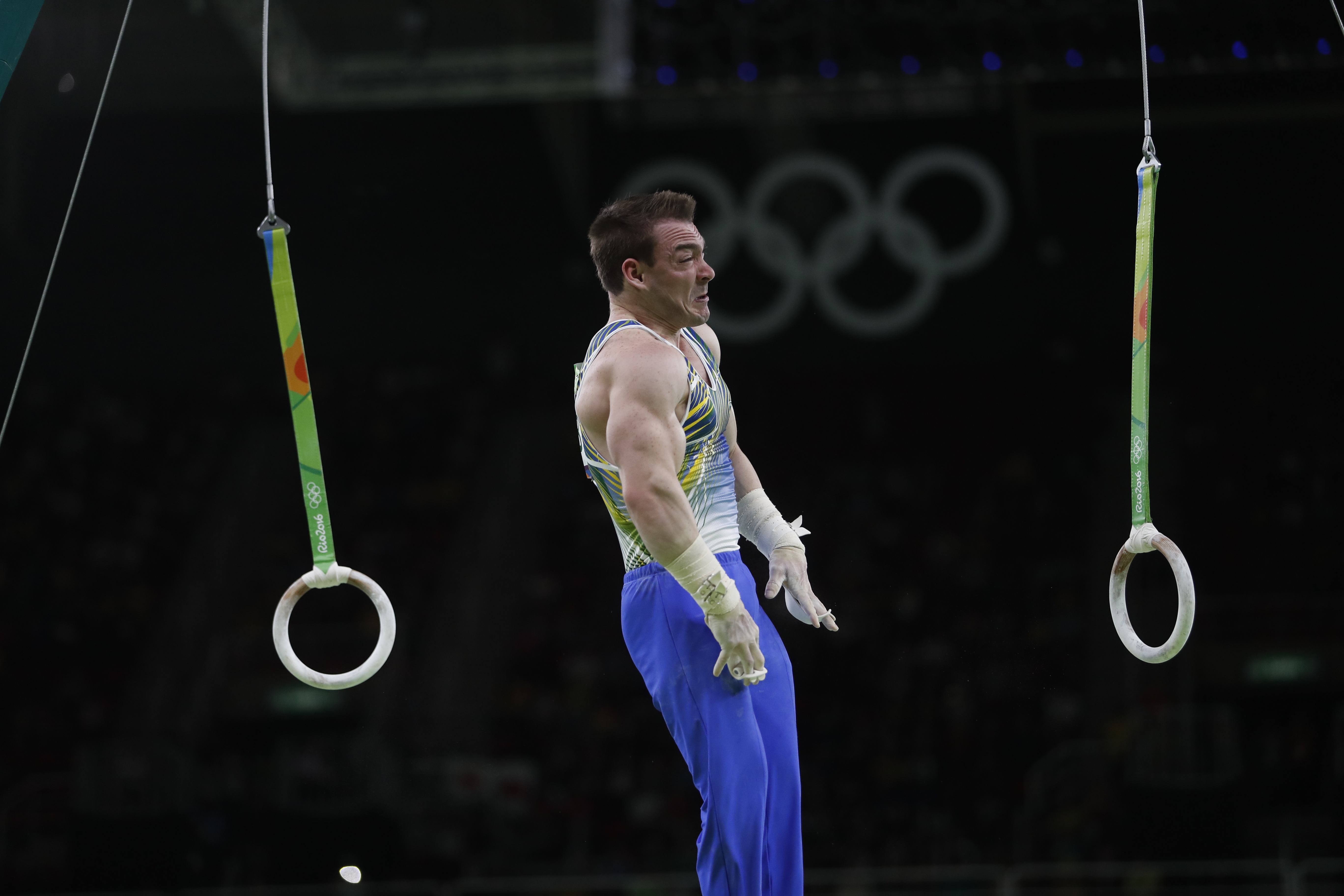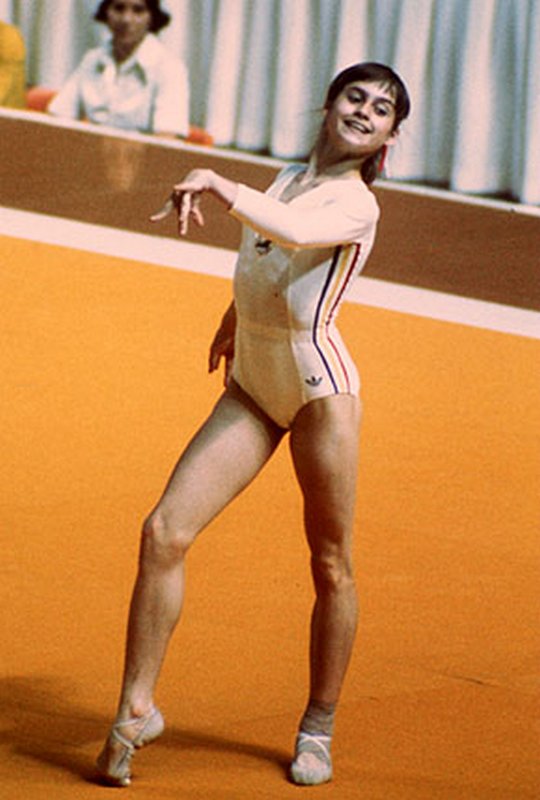|
CNA Arena Akita
CNA Arena Akita is an arena in Rinkai-area, Akita, Japan. It is owned and run by the city. Cable Networks Akita acquired its naming rights in 2015. The silver-colored building opened in 1994 and holds 5,000 people. The gym has a dome-shaped 154 feet height ceiling, and added 2,088 extra seatings in 2016. It is the home arena of the Akita Northern Happinets of the B.League, Japan's professional basketball league. The biggest basketball court in Akita is Akita Prefectural Gymnasium. Facilities *Main arena - 2,540m2 (63.5m×40m) *Sub arena - 863m2 (38.0m×22m) *Table tennis room - 324m2 *Multi-purpose hall - 324m2 *Running course - 810m2 Sports Events CNA Arena has hosted the following sports events: * 2001 World Games - Acrobatic gymnastics, Aerobic gymnastics, Rhythmic gymnastics, Dancesport, Trampoline gymnanastics * National Sports Festival of Japan - Gymnastics (2007) * bj Leaguebr>All-Star Game(2014) * Akita Masters Sports events at former municipal gymnasium in Sa ... [...More Info...] [...Related Items...] OR: [Wikipedia] [Google] [Baidu] |
Akita, Akita
'Autumn field' is the capital Cities of Japan, city of Akita Prefecture, Japan, and has been designated a Core cities of Japan, core city since 1 April 1997. , the city has an estimated population of 305,625, 136,628 households and a population density of 340 persons per km2. The total area of the city is . History The area of present-day Akita was part of ancient Dewa Province, and has been inhabited for thousands of years. The Jizōden Site, Jizōden ruins within the city limits are a major archaeological site with artifacts from the Japanese Paleolithic period through the Jōmon period, Jōmon and Yayoi periods. During the Nara period, the Yamato dynasty, Yamato court established Akita Castle in 733 AD to bring the local Emishi tribes under its control. The area was ruled by a succession of local samurai clans in the Sengoku period, before coming under the control of the Satake clan of Kubota Domain during the Edo period. Under the Tokugawa shogunate, a castle town developed ar ... [...More Info...] [...Related Items...] OR: [Wikipedia] [Google] [Baidu] |
Gymnastics
Gymnastics is a type of sport that includes physical exercises requiring balance, strength, flexibility, agility, coordination, dedication and endurance. The movements involved in gymnastics contribute to the development of the arms, legs, shoulders, back, chest, and abdominal muscle groups. Gymnastics evolved from exercises used by the ancient Greeks that included skills for mounting and dismounting a horse, and from circus performance skills. The most common form of competitive gymnastics is artistic gymnastics (AG), which consists of, for women (WAG), the events floor, vault, uneven bars, and beam; and for men (MAG), the events floor, vault, rings, pommel horse, parallel bars, and horizontal bar. The governing body for gymnastics throughout the world is the Fédération Internationale de Gymnastique (FIG). Eight sports are governed by the FIG, which include gymnastics for all, men's and women's artistic gymnastics, rhythmic gymnastics, trampolining (including double mini-t ... [...More Info...] [...Related Items...] OR: [Wikipedia] [Google] [Baidu] |
Alvark Tokyo
Alvark Tokyo is a Japanese professional basketball team located in Tokyo. The team, which is sponsored by Toyota, currently plays in the Japanese B.League. Until 2000, the team was known as the Toyota Pacers. Founded as Toyota Pacers in 1948, the club won two consecutive JBL Super League league titles in 2006 and 2007. In July 2015, it was announced that the team would compete in the first division of the new Japan Professional Basketball League, which commenced from October 2016. As of 2020, the team has been the reigning back-to-back champion of the B.League, Japan's top basketball league. Kaz Nagatsuka (''The Japan Times''), 12 May 2020. Accessed 25 May 2020. Honours Domestic [...More Info...] [...Related Items...] OR: [Wikipedia] [Google] [Baidu] |
Parallel Bars
Parallel bars are floor apparatus consisting of two wooden bars slightly over long and positioned at roughly head height. Parallel bars are used in artistic gymnastics and also for physical therapy and home exercise. Gymnasts may optionally wear grips when performing a routine on the parallel bars, although this is uncommon. Apparatus The apparatus consists of two parallel bars that are held parallel to, and elevated above, the floor by a metal supporting framework. The bars are composed of wood or other material, with an outer coating of wood. The vertical members of the supporting framework are adjustable so the height of the bars above the floor and distance between the bars can be set optimally for each gymnast. Dimensions *Bar length: ± *Bar rounded profile: ± vertical by ± horizontal *Bar width: ± *Height of bar from floor: ± *Distance between bars: – (adjustable) History The parallel bars (in German ''Barren'') were invented by Friedrich Ludwi ... [...More Info...] [...Related Items...] OR: [Wikipedia] [Google] [Baidu] |
Bronze Medal
A bronze medal in sports and other similar areas involving competition is a medal made of bronze awarded to the third-place finisher of contests or competitions such as the Olympic Games, Commonwealth Games, etc. The outright winner receives a gold medal and the second place a silver medal. More generally, bronze is traditionally the most common metal used for all types of high-quality medals, including artistic ones. The practice of awarding bronze third place medals began at the 1904 Olympic Games in St. Louis, Missouri, before which only first and second places were awarded. Olympic Games Minting Olympic medals is the responsibility of the host city. From 1928– 1968 the design was always the same: the obverse showed a generic design by Florentine artist Giuseppe Cassioli with text giving the host city; the reverse showed another generic design of an Olympic champion. From 1972– 2000, Cassioli's design (or a slight reworking) remained on the obverse with a cu ... [...More Info...] [...Related Items...] OR: [Wikipedia] [Google] [Baidu] |
Horizontal Bar
The horizontal bar, also known as the high bar, is an apparatus used by male gymnasts in artistic gymnastics. It traditionally consists of a cylindrical metal (typically steel) bar that is rigidly held above and parallel to the floor by a system of cables and stiff vertical supports. Gymnasts typically wear suede leather grips while performing on the bar. Current elite-level competition uses a stainless steel core rail. The gymnastics elements performed on the horizontal bar are regulated by a Code of Points. A bar routine, which is a sequence of several bar skills, usually includes giants with various grips (overgrip, undergrip, dorsal grip, mixed grip), in-bar work, turns, release and regrasp skills, and a dismount. The horizontal bar is often considered one of the most exciting gymnastics events due to the power exhibited by gymnasts during giant swings and spectacular aerial releases and dismounts that often include multiple flips or twists and, in some cases, airborne tr ... [...More Info...] [...Related Items...] OR: [Wikipedia] [Google] [Baidu] |
Vault (gymnastics)
The vault is an artistic gymnastics apparatus which gymnasts perform on, as well as the skill performed using that apparatus. Vaulting is also the action of performing a vault. Both male and female gymnasts perform the vault. The English abbreviation for the event in gymnastics scoring is VT. The apparatus Early forms of the vault were invented by German Friedrich Ludwig Jahn. The apparatus itself originated as a "horse", much like the pommel horse but without the handles; it was sometimes known as the vaulting horse. The horse was set up with its long dimension perpendicular to the run for women, and parallel for men.What's With That Weird New Vault? an August 2004 "Explainer" article from '''' [...More Info...] [...Related Items...] OR: [Wikipedia] [Google] [Baidu] |
Rings (gymnastics)
The rings, also known as still rings (in contrast to flying rings), is an artistic gymnastics apparatus and the event that uses it. It is traditionally used only by male gymnasts, due to its extreme upper body strength requirements. Gymnasts often wear ring grips while performing. The apparatus The apparatus consists of two rings that hang freely from a rigid metal frame. Each ring is supported by a strap, which in turn connects to a steel cable that is suspended from the metal frame. The gymnast, who grips one ring with each hand, must control the movement of the rings and his or her body movements at all times. Dimensions The measurements of the standard apparatus are specified by Fédération Internationale de Gymnastique (FIG) in its ''Apparatus Norms'' document: * Inner diameter: ± * Diameter of profile: ± * Distance from point of attachment to lower inner side of the rings: ± * Distance between two points of attachment: ± Routines An exercise on rings ... [...More Info...] [...Related Items...] OR: [Wikipedia] [Google] [Baidu] |
Floor Exercise
In gymnastics, the floor is a specially prepared exercise surface, which is considered an apparatus. It is used by both male and female gymnasts. The gymnastics event performed on the floor is called floor exercise. The English abbreviation for the event in gymnastics scoring is FX. A spring floor is used in all of gymnastics to provide more bounce, and also help prevent potential injuries to lower extremity joints of gymnasts due to the nature of the apparatus, which includes the repeated pounding required to train it. Cheerleading also uses spring floors for practice. The sprung floor used for indoor athletics, however, is designed to reduce bounce. The apparatus The apparatus originated as a 'free exercise' for men, very similar to the floor exercise of today. Most competitive gymnastics floors are spring floors. They contain springs and/or a rubber foam and plywood combination which make the floor bouncy, soften the impact of landings, and enable the gymnast to gain heigh ... [...More Info...] [...Related Items...] OR: [Wikipedia] [Google] [Baidu] |
Silver Medals
A silver medal in sports and other similar areas involving competition is a medal made of, or plated with, silver awarded to the second-place finisher, or runner-up, of contests or competitions such as the Olympic Games, Commonwealth Games, etc. The outright winner receives a gold medal and the third place a bronze medal. More generally, silver is traditionally a metal sometimes used for all types of high-quality medals, including artistic ones. Sports Olympic Games During the first Olympic event in 1896, number one achievers or winners' medals were in fact made of silver metal. The custom of gold-silver-bronze for the first three places dates from the 1904 games and has been copied for many other sporting events. Minting the medals is the responsibility of the host city. From 1928 to 1968 the design was always the same: the obverse showed a generic design by Florentine artist Giuseppe Cassioli with text giving the host city; the reverse showed another generic design of ... [...More Info...] [...Related Items...] OR: [Wikipedia] [Google] [Baidu] |
Gold Medals
A gold medal is a medal awarded for highest achievement in a non-military field. Its name derives from the use of at least a fraction of gold in form of plating or alloying in its manufacture. Since the eighteenth century, gold medals have been awarded in the arts, for example, by the Royal Danish Academy of Fine Arts, usually as a symbol of an award to give an outstanding student some financial freedom. Others offer only the prestige of the award. Many organizations now award gold medals either annually or extraordinarily, including various academic societies. While some gold medals are solid gold, others are gold-plated or silver-gilt, like those of the Olympic Games, the Lorentz Medal, the United States Congressional Gold Medal and the Nobel Prize medal. Nobel Prize medals consist of 18 karat green gold plated with 24 karat gold. Before 1980 they were struck in 23 karat gold. Military origins Before the establishment of standard military awards, e.g., the Medal of Honor, ... [...More Info...] [...Related Items...] OR: [Wikipedia] [Google] [Baidu] |
Yukio Endō
was a Japanese artistic gymnast, Olympic champion and world champion. He was part of the first Japanese team that succeeded to win gold medals in the team event at the Summer Olympics (1960) and World Championships (1962). In 1964 he won the first individual all-around Olympic gold medal for Japan. He was the flag bearer at the 1968 Summer Olympics. Early life Endō was born into a family of pharmacists. His mother died from tuberculosis when he was a nine-year-old student at Hiroomote Elementary School. He studied at Kubota Junior High School and Akita Technical High School, after which he studied at the Tokyo University of Education (now the University of Tsukuba), graduating in 1959. He later worked as assistant instructor of physical education at Nihon University. Career Endō won gold medals with the Japanese team in three Olympics, in 1960, 1964 and 1968. [...More Info...] [...Related Items...] OR: [Wikipedia] [Google] [Baidu] |
